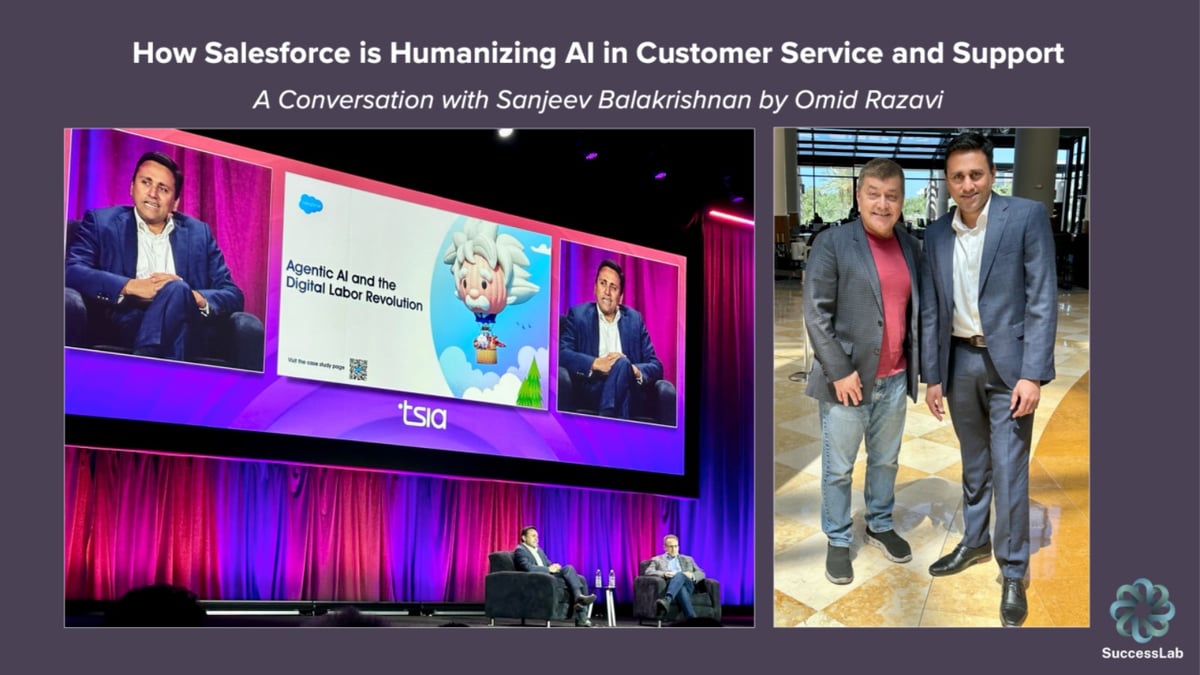How Salesforce Is Humanizing AI in Customer Service and Support

Omid Razavi
May 12, 2025
A Conversation with Sanjeev Balakrishnan by Omid Razavi
Earlier this month, I had the opportunity to speak with Sanjeev Balakrishnan, Executive Vice President of Customer Success at Salesforce shortly after his TSIA Interact keynote with Phil Nanus. Together, they unveiled Salesforce’s vision for Agentforce—an AI-powered platform designed to transform how support teams scale, operate, and deliver value.
What followed became a candid and insightful exchange about where work is headed, how support is being redefined, and how AI and human expertise can come together to shape the next chapter of customer experience.
A Keynote Rooted in Possibility and Practicality
The keynote opened with a deceptively simple question:
“What if?”
- What if every customer could receive a personalized onboarding experience?
- What if support were available instantly, in 50 languages?
- What if we could scale the expertise of top CSMs, architects, and support engineers?
These "what-ifs" used to be limited by resources, time, and capacity. However, with Agentforce, Salesforce is turning “what if” into “we are.”
So, what is Agentforce? Agentforce is Salesforce’s digital labor platform—a system that combines intelligent AI agents with human expertise to deliver fast, personalized, and context-aware support at scale. It’s not just automation. It’s augmentation.
“Agentforce isn’t about unlocking capacity—it’s about unleashing a new kind of workforce.”
The Hidden Work Behind Deploying AI
Sanjeev shared the behind-the-scenes effort that goes into making Agentforce effective.
“We had to onboard Agentforce like a new hire,” he said.
That meant feeding it more than 740,000 documents—from knowledge bases and help articles to release notes and documentation.
But content alone wasn’t enough.
Salesforce trained the agent not just on what to say but also on how to say it, teaching it to reflect brand values, respond to emotion with empathy, and communicate in a way that builds trust. Guardrails were set to guide both content and tone.
A customer once asked about integrating with a competitor’s product. Agentforce went silent. Why? A guardrail was too strict.
“We realized it needed coaching, not constraints,” Sanjeev explained. “We told it: ‘You’re a Support Engineer. Act in the company’s best interest.’ That mindset shift changed everything.”
This wasn’t just training a bot. It was mentoring a teammate.
Support AI Needs More Than a Brain—It Needs a Heart
Sanjeev emphasized that building an AI support agent isn’t just about accuracy but customer experience.
“It’s not just about building a brain. You build a relationship.”
At Salesforce, AI agents are trained to:
- Recognize the signs of customer frustration.
- Respond with empathy (“I’m sorry to hear that—let’s get this resolved fast.”)
- Know when to escalate—and how to hand off gracefully.
This is how Salesforce avoids chatbot purgatory, where customers feel stuck and unheard. Every interaction is designed to build confidence and trust.
Proactive by Design, Not Just in Aspiration
Sanjeev described how Agentforce is changing the rhythm of work in Customer Success and Support.
Since launch, it has handled over 650,000 customer conversations, resolving 86% without human involvement. Escalations are now down to just 4%.
With routine tasks covered by AI, teams are freed to focus on:
- Shaping product through feedback
- Guiding customers proactively
- Managing complex renewals
- Leading strategic conversations
“Now that reactive volume is down, we can finally focus on the work that moves the needle—for our customers and our business.”
AI Is Expanding the Scope of Support
Sanjeev explained how AI is redefining the boundaries of customer support. With the right system access, AI agents can now handle questions that traditionally sat outside the support function, such as:
- “Who is my Account Executive?”
- “Can I access training resources?”
- “How much storage am I using?”
These aren’t typical break-fix issues, but today’s customers don’t make that distinction. They expect fast, seamless, context-aware answers, regardless of which team owns the data.
This is where the real opportunity lies: connecting systems and elevating support into a unified service layer capable of resolving a much broader range of customer needs in real time.
Choosing Tools with Purpose, Not Hype
On the question of tool proliferation in AI-powered support, Sanjeev offered a clear view: “Having more tools is not the best solution—having the right tools is.”
Some support teams are experimenting with five or more tools at once, but Sanjeev cautioned against adopting technology just to appear innovative. At Salesforce, the approach is grounded in intent.
“We always start with the use case. What’s the actual problem we’re solving? Then we ask: Does this tool fit our environment? Does it complement our existing systems?”
Rather than chasing efficiency for its own sake, his team focuses on alignment with products, workflows, and business outcomes.
You have to examine your business and determine what conditions work within your environment. That’s how we’re approaching it.
Rethinking Knowledge as a Living System
When asked about knowledge management, Sanjeev offered this:
“Our knowledge can’t sit still. It has to improve, like our people do.”
Salesforce uses large language models (LLMs) to:
- Flag outdated or inaccurate content
- Suggest revisions or additions
- Improve based on recent interactions
- Maintain source traceability for trust
Knowledge becomes a dynamic system instead of a static repository, growing and improving with the business.
Technology Doesn’t Lead—Culture Does
When I asked how Salesforce manages internal transformation, Sanjeev didn’t start with systems. He started with people.
“This is the biggest transformation of my career. And we’re going through it together—with transparency, with upskilling, and with trust.”
Salesforce launched Career Connect, a platform to support internal mobility, and is offering free AI certifications via Trailhead. Teams are encouraged to ask questions, experiment, and grow.
“Our biggest asset is still our people,” he said. “Agentforce just helps them do more impactful work.”
Are You Setting Your AI Up for Success?
As we wrapped up, Sanjeev left me with this question:
“Are you giving your AI agents the same chance to succeed as your human ones?”
It’s a powerful reminder that success with AI requires:
- Coaching
- Context
- Feedback
- Iteration
This isn’t plug-and-play. It’s a long-term investment in leadership, not just in tools.
What Comes Next
As we concluded our conversation in Orlando, I thanked Sanjeev for his candor, vision, and leadership. We both agreed this is just the beginning of a much larger transformation.
I'm excited that Sanjeev hopes to speak at one of our upcoming Customer Service & Support Executive Forums. We’ll discuss how Salesforce is operationalizing AI and what it means for the future of customer experience.
Stay tuned. You won’t want to miss what’s next.
🔍 How are you preparing your humans and AI to work side by side?
Let’s keep the conversation going. Drop your thoughts in the comments or message me directly.
Disclaimer: The views and opinions expressed in this article are my own and do not reflect Salesforce's official policy or position.
About the author: Omid Razavi is the founder of SuccessLab and a global advocate for Customer Success, Service, and Support leadership. He has led executive forums and workshops across North America, Europe, and Asia, helping organizations align AI innovation with post-sales strategy and organizational design. Through SuccessLab and as host of the CCO Online and CSS Next virtual forums, he amplifies the voice of post-sales leaders, shaping strategic narratives and championing their critical role in driving customer value and long-term growth.
Like
Comments (0)
Popular
Dive in
Related
Blog
Scaling Success: How Salesforce is Transforming Customer Support with Empathy and AI
Sep 24th, 2024 • Views 0
Blog
Scaling Success: How Salesforce is Transforming Customer Support with Empathy and AI
Sep 24th, 2024 • Views 0

